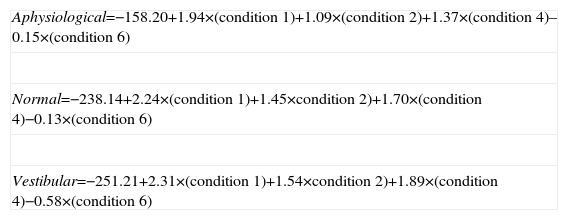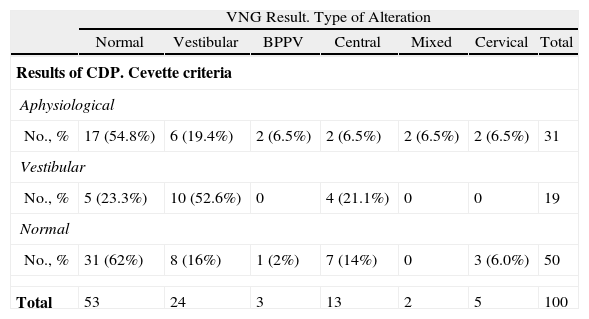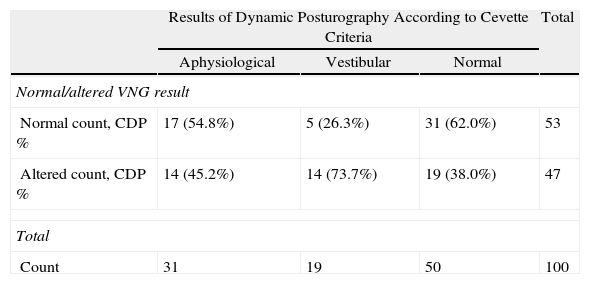Medical-legal implications of dizziness and imbalance in work-related patients are important. In these cases, computerized dynamic posturography (CDP) adds information to standard vestibular tests and aphysiologic patterns have been described. The objective is to assess the prevalence of aphysiologic performance on CDP in work-related patients complaining of dizziness/imbalance.
Materials and methodsRetrospective review of patients referred by the workers’ compensation board for assessment of dizziness, imbalance or both. Standard vestibular assessment including CDP was carried out in all patients. The sensory organization test (SOT) summaries were scored as normal, aphysiologic or vestibular using the scoring method published by Cevette et al. in 1995.
ResultsAphysiologic performance in SOT, evaluated with the Cevette formula, was found in 31 out of 100 cases. Low composite score results and aphysiologic SOT results had a statistically significant association (P=.01). Videonystagmography (VNG) was altered in 14 out of 31 cases with aphysiologic SOT.
ConclusionThe 31% prevalence of aphysiologic results on CDP among work-related patients complaining of dizziness/imbalance is relatively high in comparison with the 25% published by Longridge and Mallinson in 2005. However, aphysiologic performance should not necessarily be related to malingering or exaggeration and altered vestibular tests are found in some of these cases.
El vértigo y la inestabilidad tienen una importante implicación médico-legal en el paciente laboral. La posturografía dinámica computarizada (PDC) aporta información adicional a las pruebas vestibulares estándar, pero además se han descrito patrones de control postural compatibles con escasa colaboración o falta de sinceridad al esfuerzo, denominados afisiológicos. El objetivo de este trabajo es determinar la prevalencia de test afisiológicos en estudios de PDC sobre pacientes laborales con vértigo y/o inestabilidad.
Material y métodosEstudio retrospectivo de pacientes remitidos por mutuas laborales para estudio de vértigo y/o inestabilidad. Se realizó un estudio vestibular estándar y PDC. Los resultados de la prueba de organización sensorial (sensory organization test [SOT]) se valoraron como normales, vestibulares o afisiológicos usando el método de cálculo publicado por Cevette et al. en 1995.
ResultadosEl patrón afisiológico en el SOT, definido por los índices de Cevette, se observó en el 31% de los casos estudiados. Se ha encontrado una relación estadísticamente significativa (p=0,01) entre los valores bajos de la puntuación compuesta (composite score) y el resultado afisiológico. La videonistagmografía (VNG) presentaba alteraciones en 14 de los 31 casos con SOT afisiológico.
ConclusionesLa prevalencia de casi un tercio de los resultados de PDC afisiológicos entre pacientes laborales con vértigo y/o inestabilidad en nuestro medio, es relativamente elevada en comparación con el 25% publicado por Longridge y Mallinson en 2005. El patrón afisiológico no necesariamente significa simulación o exageración, siendo frecuente la presencia concomitante de signos videonistagmográficos de vestibulopatía en estos casos.











